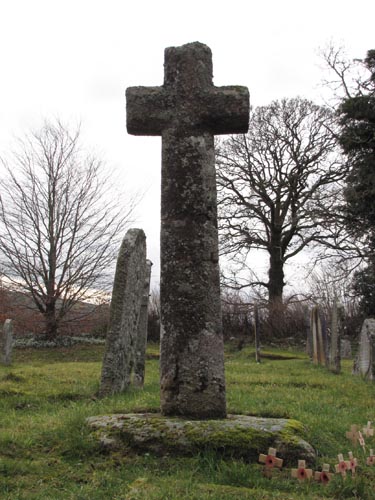 Location:
Near the South porch of the
church. Location:
Near the South porch of the
church.O/S Grid Ref: SX/71887/76785 Longitude/Latitude (Degrees+/-): -3.81071/50.57671 Map location: Click here to view map. Purpose: Churchyard Cross. Size: 6 feet 2 inches (1.88 metres) high. 2 feet (0.61 metres) across the arms. The shaft is 10 inches (0.25 metres) deep. Information: This much repaired cross stands in an ancient socket stone, which is square at the bottom and chamfered above. Similarly, the base of the shaft is square with the upper part and the rest of the cross having chamfered edges. The cross has been reassembled from several fragments and it is unlikely that they all came from the same original cross. Certainly one of the arms is a modern replacement, made especially for this cross. Mr G. W. Ormerod once reported that part of the shaft and the head of what is thought to be the original churchyard cross was found built into the east wall of the churchyard. Also, a piece of the shaft, measuring 20 inches long, was found in the staircase leading up to the rood-loft. This was in January 1876, when some workmen were reopening a walled-up Gothic doorway in the northern aisle of the church. It was at this time that the three Widecombe Church Crosses were discovered, that are now placed inside the church beside the door that leads to the tower.
In order to mark the new
millennium, the Widecombe Parish Council decided to bury a time capsule
on the village green. To keep
Beatrice obviously had a great
passion for the moor and she wrote very descriptively of its beauty in her
books. She also campaigned against Dartmoor being turned into a National
Park and was She was instrumental in reviving the annual Widecombe Fair, when it was flagging during the 1930’s and was little more than a sheep sale. She sent a telegram to the BBC and got the fair a mention on the 10 O’clock News, together a playing of the Uncle Tom Cobley song. She was also very friendly with Peter Hicks, who used to play Uncle Tom Cobley, at the fair. Unfortunately, she died penniless at the Newton Abbot Infirmary and although she left her house to her great friend Peter Hicks, he was also left with a large mortgage to pay off. Her grave is situated opposite that of her mother and her headstone bears the inscription: ‘Pray For Olive Katharine Parr’ on one side and ‘Beatrice Chase 1874-1955’ on the other. This was funded by a small committee at the suggestion of another of her friends, Enid Shortbridge. |